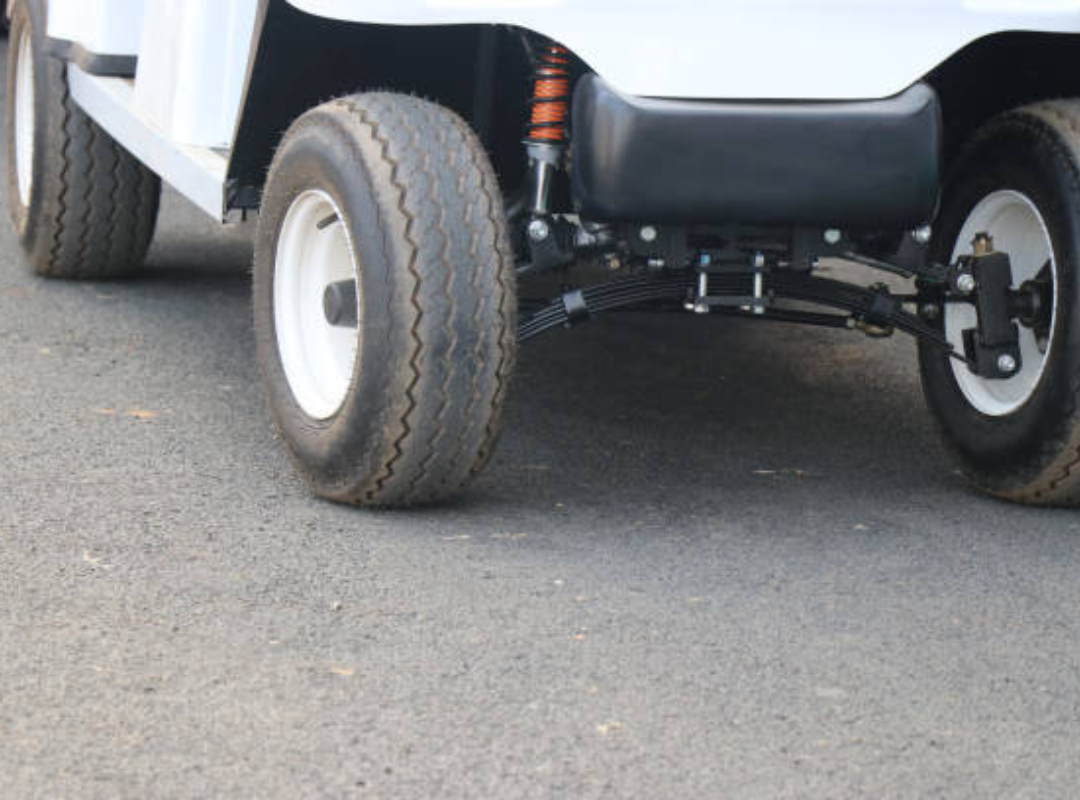A golf cart’s suspension system is crucial in ensuring a smooth and comfortable ride, whether you’re navigating a golf course, campground, or neighborhood. Over time, wear and tear can take a toll on the suspension system, affecting your golf cart’s performance, safety, and overall ride quality. Knowing when to replace your cart’s suspension parts is vital for maintaining optimal functionality and avoiding costly repairs. This guide will help you identify signs of suspension problems and determine when it’s time for a replacement.
Understanding Your Cart’s Suspension System
The suspension system in a golf cart is responsible for absorbing shocks, maintaining stability, and providing a comfortable driving experience. Key components of a cart’s suspension include:
- Springs: Often leaf or coil springs, are designed to support the cart’s weight and absorb road impacts.
- Shock Absorbers: These dampen the energy from bumpy surfaces and prevent excessive bouncing.
- Bushings: These small but critical components reduce friction between suspension parts.
- Control Arms: These connect the cart’s chassis to the suspension system and allow for controlled movement.
When one or more of these components fails, your golf cart’s handling, stability, and comfort can be compromised. Regular maintenance and timely replacement of worn-out parts are essential.
Signs Your Cart’s Suspension Needs Attention
Recognizing the signs of a failing suspension system can save you from unexpected breakdowns and costly repairs. Here are the most common indicators that it’s time to replace your cart’s suspension parts:
Uneven Tire Wear
If you notice uneven wear on your golf cart’s tires, it could point to a misaligned or damaged suspension system. Worn suspension parts can prevent the tires from maintaining proper contact with the ground, leading to faster tire deterioration. Replacing faulty suspension components can help restore alignment and extend tire life.
Excessive Bouncing
When driving over bumps or uneven terrain, your cart should quickly stabilize after an initial jolt. If it continues to bounce excessively, it’s a clear sign that the shock absorbers or springs are worn out. Replacing these parts will enhance the cart’s ability to handle rough surfaces.
Noisy Operation
Unusual noises such as squeaking, clunking, or rattling while driving are often caused by worn-out bushings or loose suspension components. These noises not only disrupt your ride but also indicate that your cart’s suspension is under strain and may require immediate attention.
Steering Problems
Difficulty steering, pulling to one side, or a loose steering feel are all signs of suspension issues. A failing suspension system can impact your cart’s alignment and steering responsiveness, which can make driving unsafe.
Sagging or Leaning
If one side of your cart appears to sag or lean lower than the other, the springs have likely lost their tension. Replacing the damaged springs will help restore balance and ensure even weight distribution.
Why Regular Suspension Maintenance Matters
Ignoring suspension problems can lead to further damage, not just to your cart’s suspension but also to other components like the chassis and tires. Routine maintenance ensures that minor issues are addressed before they become costly repairs. A well-maintained suspension system also improves ride quality, reduces strain on other parts, and extends the lifespan of your golf cart.
When to Replace Suspension Parts
Replacing your cart’s suspension parts largely depends on how often you use your golf cart and the terrain you drive on. Below are general guidelines to help you determine when it’s time for replacements:
After 3-5 Years of Regular Use
For most golf carts, the suspension system lasts about 3-5 years under normal conditions. However, if you frequently drive on rough or uneven terrain, the suspension may wear out more quickly.
Based on Mileage
If your golf cart has been driven extensively, suspension parts may need replacement after 10,000 to 20,000 miles. Keep track of your mileage and inspect the suspension components regularly.
After Visible Damage
Inspect your cart’s suspension system for visible signs of damage, such as bent control arms, broken springs, or cracked bushings. Any damaged components should be replaced promptly.
When Ride Quality Declines
If your cart no longer offers a smooth and stable ride, it’s time to assess the suspension system. Don’t wait until the ride becomes unbearable; replacing worn parts early can save you from further complications.
Choosing the Right Replacement Parts
When replacing your cart’s suspension parts, quality should be a top priority. Choose components that are compatible with your golf cart’s make and model and are built to withstand wear and tear. OEM (Original Equipment Manufacturer) parts are often the best choice, as they are designed to meet the specifications of your cart.
Additionally, professional suspension service for carts in DE can ensure that the replacement process is handled correctly. Expert technicians can identify underlying issues, recommend high-quality parts, and restore your golf cart to peak performance.
DIY vs. Professional Suspension Repair
While some golf cart owners prefer to handle minor repairs themselves, replacing suspension components can be a complex task. It often requires specialized tools and expertise to ensure proper installation and alignment. Here are some factors to consider:
- DIY Repairs: Suitable for small tasks like replacing bushings or lubricating parts, provided you have the necessary tools and knowledge.
- Professional Service: Ideal for larger repairs, such as replacing springs, shock absorbers, or control arms, to ensure safety and accuracy.
Investing in professional repairs can save you time, effort, and potential errors. Plus, expert technicians can perform a comprehensive inspection to address any additional issues.
Maintaining Your Cart’s Suspension for Longevity
Regular maintenance is key to prolonging the life of your cart’s suspension system. Here are some tips to keep it in top condition:
- Inspect Components Regularly: Check for signs of wear, damage, or corrosion, especially if you frequently drive on rough terrain.
- Keep the Suspension Clean: Dirt and debris can accumulate and cause premature wear. Clean the suspension components periodically.
- Lubricate Moving Parts: Proper lubrication reduces friction and extends the life of bushings and other moving parts.
- Avoid Overloading: Exceeding your cart’s weight capacity can strain the suspension system and lead to premature failure.
By following these simple steps, you can prevent unnecessary repairs and ensure your cart remains safe and comfortable to drive.
Final Thoughts
Your cart’s suspension system plays a critical role in ensuring safety, comfort, and reliability. By paying attention to the signs of wear and replacing parts when necessary, you can extend the lifespan of your golf cart and avoid costly repairs. Whether you’re dealing with sagging springs, noisy bushings, or uneven tire wear, timely action is essential to maintaining peak performance. Don’t hesitate to consult professionals for a thorough suspension service for carts to ensure your cart’s suspension system is in top condition. Prioritizing maintenance and repairs will not only enhance your driving experience but also protect your investment for years to come.





